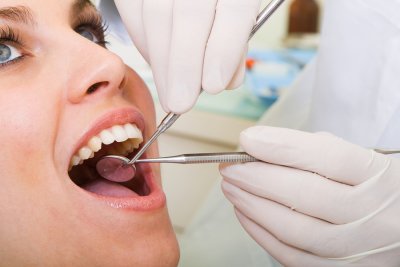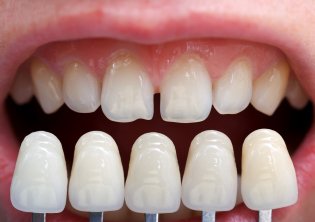-
The Advantages of Sedation Dentistry
 Are you one of the many people who postpone or completely avoid your dentist serving St. Louis because of fear? Dental phobia is a common problem, but help is available if only you talk to your dentist. Sedation dentistry can allow you to get the dental care that is so vital to your overall well being without the intense fear.
Are you one of the many people who postpone or completely avoid your dentist serving St. Louis because of fear? Dental phobia is a common problem, but help is available if only you talk to your dentist. Sedation dentistry can allow you to get the dental care that is so vital to your overall well being without the intense fear. There are a few different kinds of sedation dentistry options. Nitrous oxide is a mild sedative that you can inhale via a nose hood. IV sedation is delivered by injection and provides a higher level of sedation. For those patients who want the benefits of IV sedation without the use of needles, oral conscious sedation is a good option. Your dentist can help you make a decision about the right method of sedation for you based on your level of fear and the dental procedure you’re having. Nitrous oxide may be appropriate for dental cleanings and fillings, while you may wish for a stronger, longer-lasting method for lengthier procedures, like a same-day dental implant.
-
Getting Ready for Your Root Canal
 Root canals get a bad rap. Patients often fear this procedure before actually having it, but your dentist can tell you that it’s really a simple process that usually doesn’t cause any more discomfort than a standard cavity filling. Although no special preparation is required, knowing what to expect from the process can help you get ready for the procedure. Here are the facts you need to know before your root canal in St. Louis to help you get ready.
Root canals get a bad rap. Patients often fear this procedure before actually having it, but your dentist can tell you that it’s really a simple process that usually doesn’t cause any more discomfort than a standard cavity filling. Although no special preparation is required, knowing what to expect from the process can help you get ready for the procedure. Here are the facts you need to know before your root canal in St. Louis to help you get ready. Root Canals Explained
Root canals are used to treat tooth decay that has become too invasive to treat with a normal filling. During the procedure, your dentist or endodontist removes infected tooth pulp and fills the entire pulp cavity. This process helps prevent infection from spreading to neighboring teeth or deeper into the nerves. In most cases, root canals relieve nagging tooth pain almost immediately.
Procedure Breakdown
Your dentist will prepare you for your root canal by first numbing your gums with a topical anesthetic and then injecting a local anesthetic into the treatment area. He or she may place a rubber dam over the tooth to separate it from neighboring teeth and to prevent tooth chips and liquid from entering your mouth. After drilling into the tooth, your dentist will use a series of scrapping devices to completely remove the pulp. After the area is cleaned and filled, you will likely need a crown to rebuild the tooth structure.
Root Canal Recovery
After the root canal, you will likely be numb for the next few hours. When the anesthetic wears off, you may have some discomfort in the treatment area. Over-the-counter painkillers are sufficient for most people, but talk to your dentist if you need a stronger pain medication. If you have a condition that slows your recovery, like a heart valve problem or diabetes, your dentist may also prescribe antibiotics.
-
All About Laser Dentistry [INFOGRAPHIC]
If you’re like many people, going to a dentist serving St. Louis for a filling or periodontal disease treatment may not be high on your list of favorite things. However, thanks to laser dentistry, your next dental visit could be much less painful and more efficient than ever before. Lasers were approved for dental use in 1990 and can be used to treat tooth decay, control gum disease, contour the gums, and remove tissue for biopsies. Because lasers are more precise than dental drills and scalpels, more healthy tissue and tooth structure is left intact during treatments. Check out this infographic from West County Dental, a St. Louis periodontist’s office, to learn more about laser dentistry, what it’s used for, and its benefits. Please share it with your friends and family!
![All-About-Laser-Dentistry-Infographic[1]-min](https://www.westcountydental.com/wp-content/uploads/2020/05/All-About-Laser-Dentistry-Infographic1-min.png)
-
Are Dental Veneers Right for You?
If you are unhappy with the appearance of your smile, ask your dentist serving St. Louis if dental veneers could help you get the smile you’ve always wanted. Veneers offer a long-term solution for many cosmetic dental woes. They’re long lasting and require very little special care. Are veneers the right choice for you? Here’s what you need to know.

What Are Dental Veneers?
Dental veneers are thin shells that are attached to the surfaces of your teeth. You can have veneers attached to as few or as many teeth as you like. Veneers can be made of porcelain or resin, and because they are custom-made for you, they have a completely natural appearance. Veneers do not require any special care and last between five and 10 years before replacement is necessary.
How Are Veneers Placed?
To place veneers, your dentist will start by prepping the teeth that are being treated. It may be necessary to remove a small amount of tooth enamel to make room for the veneers. After making an impression of your mouth and having your veneers created, your dentist will etch the surfaces of your teeth to allow for better bonding, and then put the veneers in place. Before the veneers are cemented, your dentist may make several adjustments to their shape and color to achieve the results you desire.
Should You Consider Veneers?
Veneers are a great option if you have teeth that are chipped, worn, misshapen, or severely discolored. Unlike dental crowns, they don’t require the removal of a large amount of natural tooth, and they look very natural. If you plan to have your teeth whitened, be sure to do it before you get your veneers, as you can’t alter the color of your veneers once they are in place.
-
Check out our 5 Star Dental Review
Check out our 5 Star Dental Review on Google+ . At West County Dental, we make sure we take the best care of our patients. If you’ve had a great experience with us, please share it via a review.

-
What to Expect From Your Oral Surgery
Oral surgery can be used to resolve a wide range of dental health problems, from impacted canines to oral cancer. Before your procedure, your St. Louis oral surgeon will review the details of the procedure with you and help you prepare for surgery and recovery. As your oral surgery date approaches, here is an overview of what you can expect.

Preparation
Depending on your type of surgery, your dentist may ask you to have some medical testing done to ensure you don’t have any health problems that could interfere with healing. He or she may also work with your primary care doctor to alter your medication schedule for the days leading up to surgery. On the night before your procedure, be sure to follow your dentist’s prep instructions very closely, especially in terms of fasting. If you make a mistake with your preparation instructions, tell your dentist right away, as your procedure may need to be rescheduled.
Procedure
Your dentist will start by giving you anesthesia. You may receive a local anesthetic with a sedative or general anesthesia, depending on the nature of your procedure. Oral surgery lengths vary depending on the case. After recovering from your anesthesia, you will need someone to drive you home.
Recovery
After your surgery, take your pain medications and antibiotics as prescribed by your dentist. You will need to stick to a soft food diet for a few days. Talk to your dentist about when it is safe to incorporate hard or sticky foods back into your eating plan. It’s essential that you avoid smoking while recovering, as the sucking motion can damage the surgical site. Your dentist will tell you when you can resume your normal activities. Expect full healing to take two weeks to a month, depending on your type of surgery.
-
The Benefits of Single Tooth Replacement
If you have a missing tooth or are about to lose a tooth with a damaged root, then single tooth replacement could be an ideal solution for you. This method of replacement, which is completed with same day dental implants, provides a natural result that won’t compromise the health of any of your remaining teeth. Your oral surgeon in St. Louis can help you decide if single tooth replacement is the right option for you.

Although there are alternatives to same day dental implants, none offer the same great benefit of single tooth replacement. With dental implants, your replacement tooth will look and act like your natural teeth. It won’t require any special care and won’t rely on neighboring teeth for support. Your dentist can match your dental implant precisely to the color and shape of your natural teeth, so no one will know you have an implant but you. In addition to its cosmetic appeal, single tooth replacement with a dental implant is also an investment in your long-term dental health.
-
The Steps of Choosing a Dentist
The Steps of Choosing a Dentist
A dentist isn’t like a grocery store or auto repair shop—you can’t just go to the one nearest you or on the corner where you work. You need to take some time, do your research, and find a dentist in the St. Louis area that you can trust with your dental health. For starters, check the American Dental Association’s website for a member directory and schedule a consultation with dentists in your area . If the dentist has a hygienist or receptionist, discuss the costs of treatment and ask if the equipment is sterilized and serviced regularly.
Watch this video for more tips on choosing a great dentist. And remember that the most important thing about choosing a dentist is that you feel safe and comfortable with the dentist and his or her staff.
-
A Look at Dental Veneers
If you want a more durable, effective solution for changing the color of your teeth than standard whitening, talk to your dentist serving St. Louis about veneers. Veneers can permanently change the shade of your teeth, while also improving their shape and size. Watch this video to learn more.
Veneers are thin, porcelain shells that are attached to the teeth. In the past, veneers required the removal of some of the surface of your teeth, but today’s veneers are so strong that little to no enamel removal is required. This means you can get the transformative power of veneers without compromising any of your natural tooth structure, which is a win for the appearance of your smile as well as your long-term dental health.
-
A Patient’s Guide to Porcelain Dental Veneers
 A Patient’s Guide to Porcelain Dental Veneers
A Patient’s Guide to Porcelain Dental Veneers Thanks to advancements in tooth restoration technology, dental porcelain can be sculpted to closely replicate the look and feel of natural tooth enamel, while providing the strength and resilience of natural tooth enamel. Porcelain veneers are ideal for individuals looking to make slight position alterations, or those who wish to change the shape, size, and/or color of their teeth. And while porcelain dental veneers are technically considered a cosmetic treatment, they can also make it easier and more comfortable to chew food. If you are considering veneers, this guide will tell you what you need to know.
Bonding Veneers to Teeth
The bond is the most important aspect of a veneer. To apply a veneer, your dentist will remove a very small amount of the original tooth, usually less than a millimeter. This not only creates room for the veneer to fit within the mouth but also ensures accurate tooth function and placement. Light-sensitive resin is placed between the original tooth and the veneer and hardened using a special curing light.Caring for Porcelain Veneers
The good news about porcelain veneers is that they are quite simple to maintain—you simply treat them as you would your original teeth, with routine brushing, flossing, and visits to your St. Louis dentist. Your dentist may recommend non-abrasive fluoride toothpaste to keep your porcelain veneers looking like new. And if you have a habit of grinding or clenching your teeth at night, your dentist may fit you with a nighttime bite guard to avoid damaging your veneers .Pros and Cons of Porcelain Veneers
There are alternatives to porcelain veneers, so it helps to know the pros and cons before you have them applied. One major benefit of porcelain veneers is that they look and feel identical to natural teeth. Custom-made veneers also resist coffee and tea stains and cigarette smoke. On the downside, a veneer is not considered a reversible treatment, as a portion of the original tooth must be reduced prior to application. Porcelain veneers are also brittle and should not be used to chew on ice, bite fingernails, or open bottles with.
categories
- Uncategorized
- crowns
- dental veneers
- dentists
- full service dental practice
- porcelain veneers
- same day crowns
- Dental Cosmetic Surgery
- Dental Implants
- Dentistry
- Dentist Review
- Laser Dentistry
- Root Canal
- Sedation Dentistry
- Dentures
- Cleanings
- Teeth Whitening
- Abscessed Teeth
- Cosmetic Dentistry
- Infographic
- Cavities
- Sealants
- Gum Recession
- Periodontal Disease
- Dental Health
- Family Dentistry
- Dental Emergency
- Invisalign
- Filling
- Same Day Dental Procedures
- Gum disease
- Sleep Apnea
- Вечірні сукні
- Вечерние и выпускные платья в Киеве 2023 года
- Яку весільну сукню купити для цивільного весілля?
- Весільний салон Київ
Archives
2024
2023
2022
2021
- December (2)
- November (1)
- October (3)
- September (2)
- August (2)
- July (2)
- June (2)
- May (2)
- April (2)
- March (2)
- January (2)
2020
2016
2015
- December (4)
- November (3)
- October (3)
- September (4)
- August (4)
- July (4)
- June (4)
- May (3)
- April (3)
- March (4)
- February (5)
- January (6)

